  Portsmouth Site Federal Project Director Jud Lilly prepares to ride along to transfer the last load of demolition debris from the X-326 Process Building.
PIKE COUNTY, Ohio – EM’s Portsmouth Site recently achieved a cleanup milestone with the last load of X-326 Process Building debris placed in the On-Site Waste Disposal Facility (OSWDF).
Demolition of the X-326 Process Building is the most significant event to occur in the decontamination and decommissioning (D&D) era at the site. In a little over a year, workers dismantled the 2,280-foot-long, 552-foot-wide and 62-foot-tall process building and turned it into more than 163,000 cubic yards of debris.
“We are proud of the progress made to safely and effectively bring down this massive structure and place it in waste disposal under budget and in record time,” Portsmouth Site Project Director Greg Wilkett said.
Crews drove the 14,960 loads of demolition debris and 39,249 loads of soil 251,193 miles while completing over 2.1 million safe work hours to complete the waste placement project.
The X-326 demolition project is comprised of D&D, soil excavation and OSWDF operations. The use of engineered fill soil excavated from legacy groundwater plumes and landfills provided the solution to the need for more than twice the amount of soil per waste deposited into each cell. Additionally, the approach prevented the need to purchase clean fill for the OSWDF and expedited the environmental cleanup of the site, providing more land for future use.
“Using lessons learned from other sites along with input from our stakeholders, the completion of the X-326 demolition and excavation of the landfills and plumes is a win-win for the site,” Portsmouth Site Lead Jeremy Davis said.
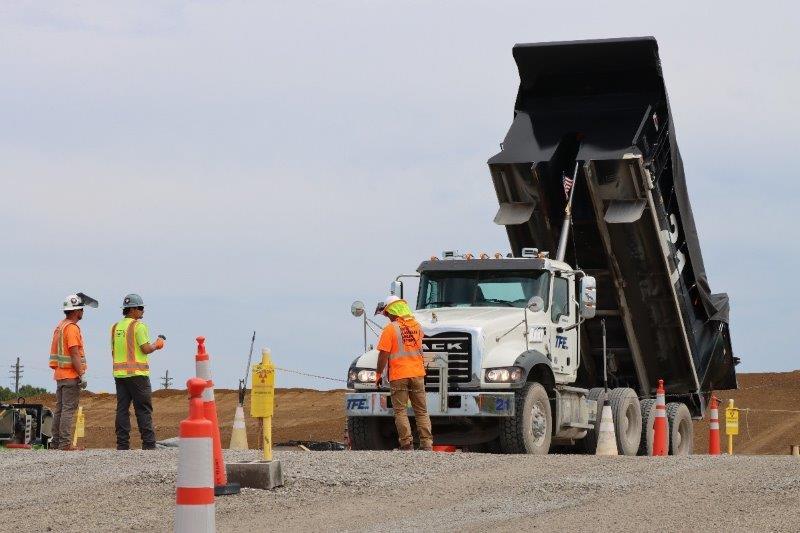 Crews monitor the last load of demolition debris from the X-326 Process Building as it is placed into the On-Site Waste Disposal Facility.
Workers from the X-326 project, the OSWDF and support projects gathered to send off the last load as Tim Lewis, the driver who delivered the first load to the OSWDF, drove the last load to its destination with Portsmouth Site Federal Project Director Jud Lilly riding along.
“This truly is a Portsmouth cleanup milestone to be proud of,” said Lilly. “The hard work of everyone involved across the Portsmouth Site and beyond has made this a safe and successful project.”
As crews close out the X-326 demolition project, work is already underway to prepare the X-333 Process Building for D&D, along with the construction of three more disposal cells at the OSWDF.
-Contributor: Shawn Jordan
 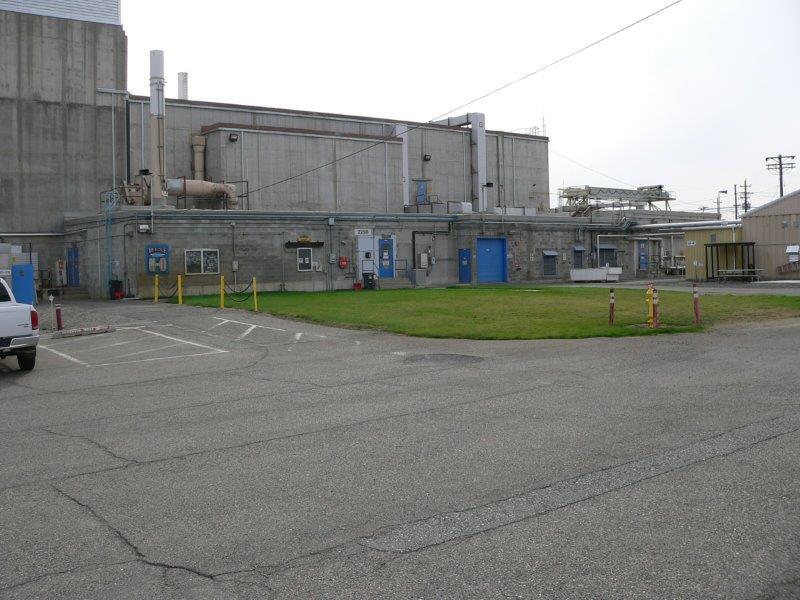 The exterior of Hanford’s Waste Encapsulation and Storage Facility, where 1,936 capsules containing cesium and strontium are stored in an underwater basin.
RICHLAND, Wash. – Workers with EM Richland Operations Office contractor Central Plateau Cleanup Company (CPCCo) recently finished extensive modifications at the Hanford Site’s Waste Encapsulation and Storage Facility (WESF), a significant step in preparations to move 1,936 radioactive capsules of cesium and strontium from the facility’s water-filled basin into dry storage casks starting in 2025.
The stainless steel capsules are generally 21 inches long and 2 ½ inches in diameter and are stored under 13 feet of water that provides shielding from radiation and keeps the capsules from overheating.
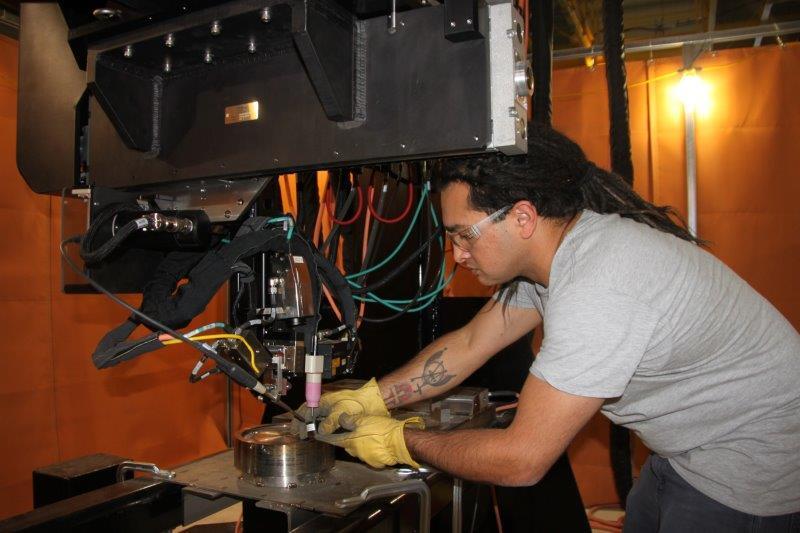 Manuel Ponce, a technician at Hanford’s Maintenance and Storage Facility, where the capsule transfer system is set up, tests an automated welding system that will attach lids to capsule sleeves and concrete casks.
The next significant step will be installing equipment for moving the capsules from the underwater basin into dry-storage casks, and then moving the dry-storage casks to a nearby concrete pad that will provide safe and compliant storage until a final disposition path is determined.
“While the capsules are safely stored in the basin, moving them to dry storage eliminates a long-term risk in the unlikely event of a larger-than-expected earthquake causing water to leak from the basin,” said Gary Pyles, EM federal project director at Hanford. “Moving the capsules out of the aging facility will reduce storage operating costs by an estimated $6 million per year and pave the way for eventual decommissioning and demolition of the facility.”
 |
|
Aerial photo of Hanford’s Waste Encapsulation and Storage Facility, showing the nearby concrete pad where workers will place dry storage casks. |
Most of the modifications were made in three areas of the facility where capsule transfer equipment will be installed — a shielded hot cell, an operating “canyon” and a truck loading area.
“The construction crews have done an excellent job preparing the nearly 50-year-old storage facility for its new mission,” said Neal Sullivan, who manages the modification and capsule removal projects for CPCCo. “They’ve spent the past two years removing interferences and either modifying, relocating or installing wiring, piping and other components to support installation of the various process systems.”
Crews at Hanford’s Waste Encapsulation and Storage Facility pour concrete for a 10-inch-thick floor inside the facility’s truck loading area. |
|
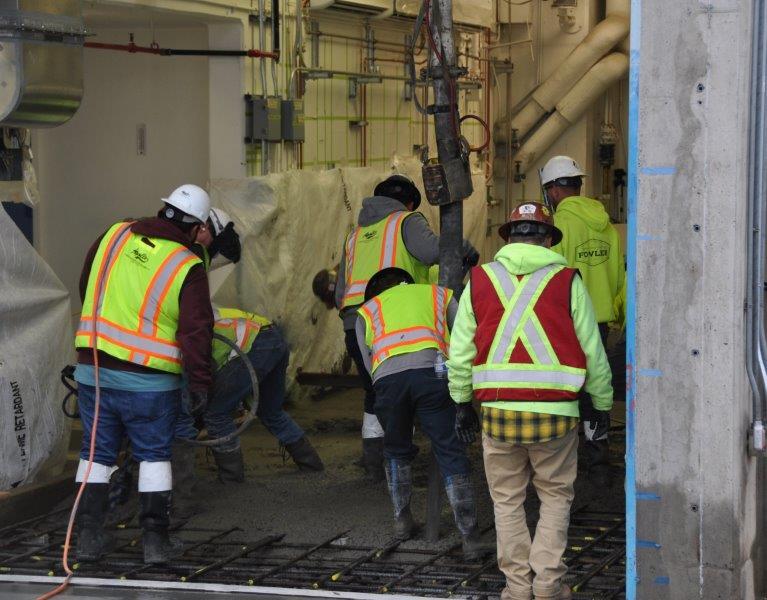 |
Meanwhile, at an on-site mock-up facility about 15 miles from WESF, CPCCo engineers and technicians began testing the capsule transfer equipment.
The mock-up contains replicas of the WESF hot cell, operating canyon and truck loading area, and helps workers train on using the capsule transfer equipment in a non-hazardous facility before starting operations at WESF.
-Contributor: Mark McKenna
  The first major shipment of depleted uranium oxide from the Portsmouth Site in Ohio recently departed in specially modified gondola rail cars bound for Texas.
PIKE COUNTY, Ohio – With the safe arrival of 120 storage cylinders by rail in west Texas last week, EM achieved another milestone in its offsite shipping and disposal of depleted uranium oxide (DUOx).
This marked the first such shipment of the stable crystalline powder from EM’s Portsmouth Site in Ohio.
Earlier this year, the first multi-car rail shipment arrived at the same licensed facility from EM’s Paducah Site in Kentucky.
“This accomplishment shows that EM can effectively and efficiently ship this material in bulk from both the Portsmouth and Paducah sites in a safe and sustainable way,” said Joel Bradburne, manager of EM’s Portsmouth/Paducah Project Office (PPPO), which oversees the project.
DUOx is converted from the Department’s more than 700,000 metric-ton inventory of depleted uranium hexafluoride (DUF6) stored and managed at both Portsmouth and Paducah.
DUF6 resulted from more than six decades of uranium enrichment at the nation’s former gaseous diffusion plants at Oak Ridge, Portsmouth, and Paducah. It is converted at Portsmouth and Paducah to both DUOx and aqueous hydrofluoric acid (HF). The DUOx is suitable for beneficial reuse, while some of it is disposed at licensed facilities. The HF co-product is recycled in industry to offset conversion costs.
More than 90,000 metric tons of DUF6 have been converted by PPPO since it commissioned specialized conversion facilities beginning in 2010.
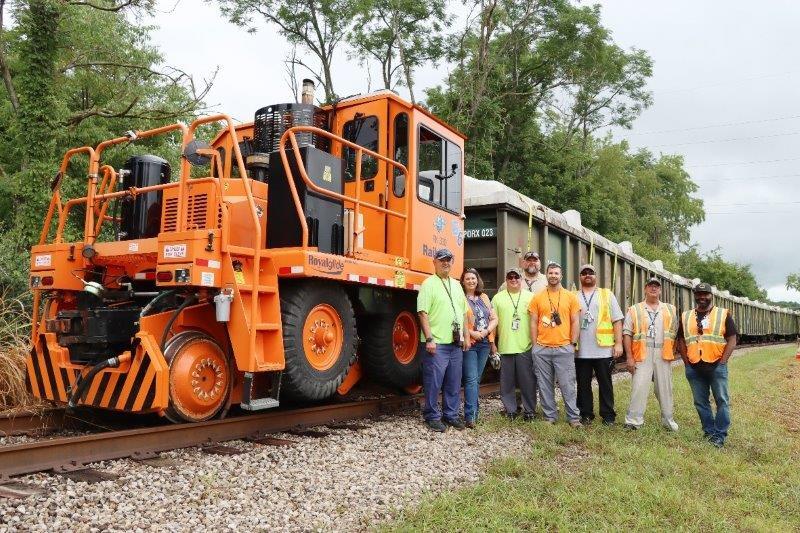 Personnel with Mid-America Conversion Services gather in front of 20 gondola rail cars containing 120 uranium oxide cylinders shortly before their recent offsite shipment from the Portsmouth Site. Left to right: Cylinder Storage Yard (CSY) Operator-Technician Bill Bowen, Logistics Manager Tara Warren, CSY Operator-Technicians Michael Scythes, Tom Lamerson, Matt Blosser, Eric Weeks, Michael Cool, and CSY Supervisor Vincent Kennedy.
“I am proud of our dedicated teams at both Portsmouth and Paducah for working out the complex logistics and coordination of such a major operation," Mid-America Conversion Services (MCS) President and Project Manager Dutch Conrad said. MCS is the operations and maintenance contractor for EM’s DUF6 project.
Conrad added that effective communication and collaboration among MCS, its United Steel Workers workforce, and the railroad — along with continuous GPS monitoring and EM oversight — continues to demonstrate safe shipments that could increase to hundreds of cylinders per year in the near future.
-Contributors: Kearney Ackermann, Donnie Locke, Michelle Teeters
  Participants of the SRNL Research SLAM. From left to right: Nathaniel Losey, Steven Demers, Sean Noble, Holly Flynn, Brad Means, Kori Mcdonald, Alex Robb, Alex Bretaña, Vincent Dinova.
AIKEN, S.C. – The Savannah River National Laboratory’s (SRNL) Research SLAM was held on Aug. 28 at the Aiken Community Theater where early career researchers from SRNL provided a short summary of their scientific work and were judged by a panel.
The National Lab Research SLAM is a collaborative effort among the 17 national laboratories to highlight the Department of Energy’s (DOE) research programs, help educate policymakers and their staff about the key role that the national labs play in the nation’s innovation ecosystem, and their impact on the nation. The House of Representatives National Labs Caucus and the Senate National Labs Caucus are sponsoring the inaugural National Lab Research SLAM.
The panel of judges included Mike Budney, DOE Savannah River Site manager; Allison Hamilton, executive director of Citizens for Nuclear Technology and Awareness; Matthew Christian, a reporter for the Aiken Standard; David Jameson from the Aiken Chamber of Commerce; and Chris Verenes, CEO of Security Federal Bank. Brad Means, anchor and reporter for WJBF in Augusta, was the emcee for the event.
Three winners were announced at the competition. First-place winner Sean Noble, an SRNL researcher, will go on to represent SRNL at the inaugural National Lab Research SLAM in Washington, D.C., on Nov. 15.
Noble said he appreciated the opportunity to share his research that he has worked so hard on with the public.
“This was an amazing experience,” said Noble. “It was great to have the chance to have some healthy competition with my fellow scientists.”
Second-place winner Steven Demers, an SRNL researcher, said he likewise appreciated the opportunity to promote his research.
“I got a lot of positive feedback of continuing the work in the future so that should motivate me a lot moving forward,” he said.
The other five SRNL scientists that participated in the Research SLAM included:
- Vincent DiNova
- Holly Flynn
- Nathaniel Losey
- Kori McDonald
- Alex Robb
SLAM’s main focus is to highlight the importance of effective science communication, especially while communicating with the general public. The event is also a great career development opportunity for participants and provides visibility into scientific disciplines and research. Participating in the SLAM promotes cross-discipline collaboration and promotes networking opportunities with other offices and labs.
-Contributor: Scott Shaw
 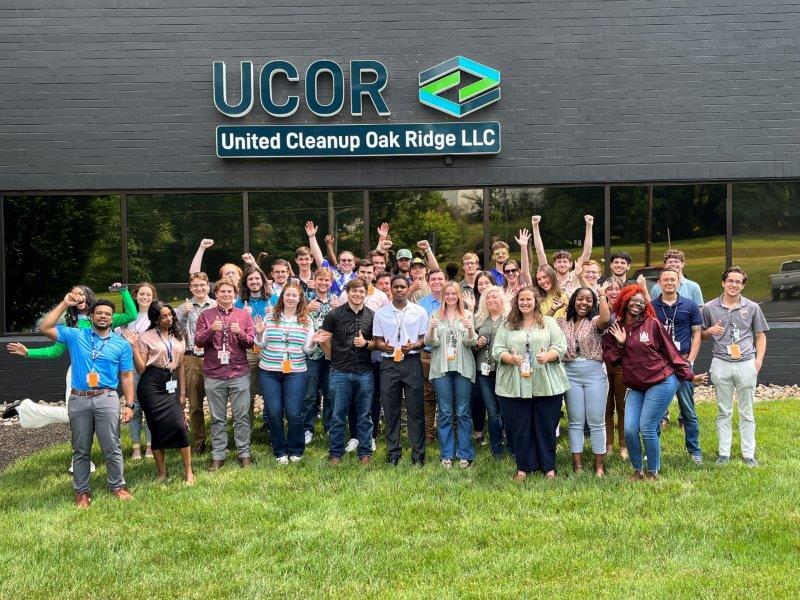 This year marks the largest summer intern program to date for OREM contractor UCOR. Forty students from 14 schools across the country gained valuable experience by supporting numerous projects across the Oak Ridge Reservation.
OAK RIDGE, Tenn. – Oak Ridge Office of Environmental Management (OREM) contractor UCOR just completed its largest ever summer internship program. Forty students from 14 schools across the country gained valuable experience, and some finished their term with job offers in hand.
With the increase in the number of students this year, there was also an increase in the number and depth of projects.
Those projects included support to the construction of the Outfall 200 Mercury Treatment Facility, safety initiatives, infrastructure life extension projects, a spill prevention control countermeasure, source inventory, contract closeouts, power re-routing, confined space gap analysis, waste profiles, and engineering instructions.
“These internships are supporting efforts to build and strengthen our future workforce in a big way,” said OREM Deputy Manager Laura Wilkerson. “We appreciate the lengths UCOR is going to identify and bring in some of the best and brightest to advance the cleanup mission in Oak Ridge.”
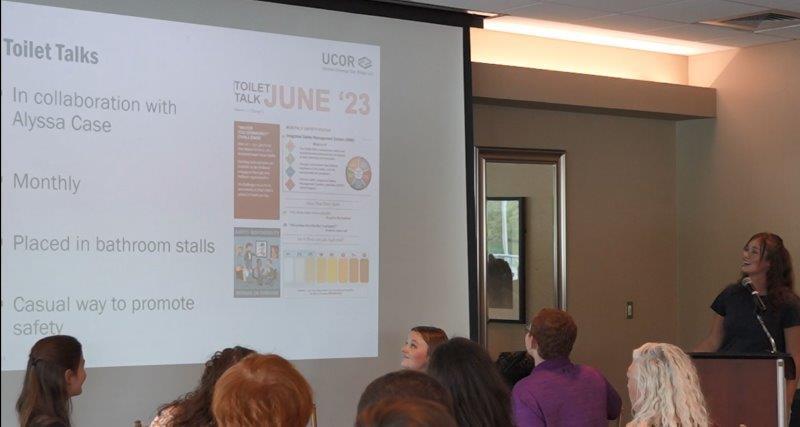 |
|
Lexi Stone, an occupational safety and health major from Murray State University, discusses safety initiatives during her closeout presentation. Stone has received a contingent offer to join the UCOR workforce upon graduating. |
This year’s class included a wide range of participants from nontraditional students to veterans and students from colleges and universities with new and existing UCOR partnerships. This year’s class also included four students from the Department of Energy’s Mentorship for Environmental Scholars (MES) program.
The MES program is a 10-week paid summer internship that provides exposure research in the areas of environmental science, environmental justice, and environmental policy. MES recruits qualified undergraduates from Historically Black Colleges and Universities, Tribal Colleges and Universities, Hispanic-Serving Institutions, and other Minority-Serving Institutions for training that will direct them toward employment in various research and management positions within the Department.
UCOR’s newest university partnership with Tennessee Tech brought eight interns to the 2023 program. Four of those returned for a second internship after supporting UCOR projects during the school year.
Following the success of an extended internship option that UCOR began offering to students last summer, select interns will continue applying the skills learned in the classroom by continuing part time throughout the upcoming academic year.
 |
|
Cobie Mooney, an engineering technology major at East Tennessee State University, is an MES student who was offered the opportunity to stay on this school year and continue providing support to the Transuranic Waste Processing Center. |
This option is especially useful for the Transuranic Waste Processing Center (TWPC), which offered extended internships to all four of its summer interns.
Cobie Mooney, an engineering technology major at East Tennessee State University, is an MES student who was among those offered the opportunity to stay on this school year.
“It’s been an amazing experience on the TWPC Project,” Mooney said. “I’m excited UCOR has invited me to continue working on design change notices while I’m back at school.”
Since UCOR began its new contract in 2022, eight students in its summer internship program have joined the workforce full time, while 16 students will continue in part-time extended internship roles.
-Contributor: Shannon Potter
 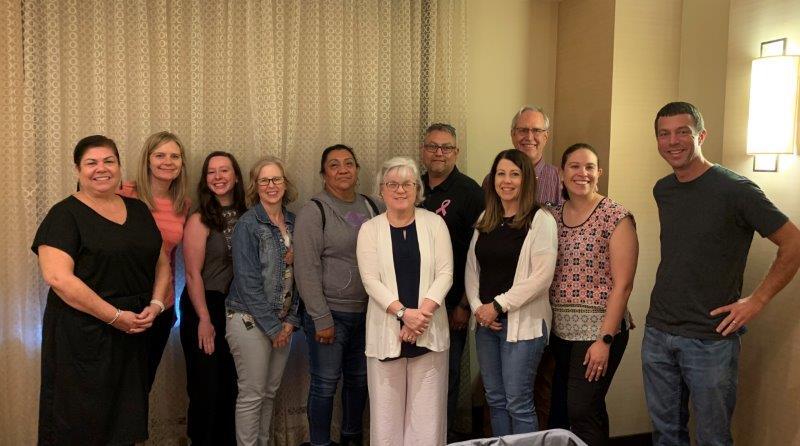
On Aug. 24 and 25, the State and Tribal Government Working Group (STGWG) Executive Committee met in Denver, Colorado, to discuss STGWG interests and issues and plan for the coming year. The Executive Committee is chaired by a state representative and a tribal representative who act as co-convenors of the fall and spring STGWG meetings and includes chairs of the Long-term Stewardship, Waste Management, Natural Resource Damage Assessment and Tribal Issues committees. The meeting was facilitated by the National Conference of State Legislators and included the EM Tribal Program Manager.
 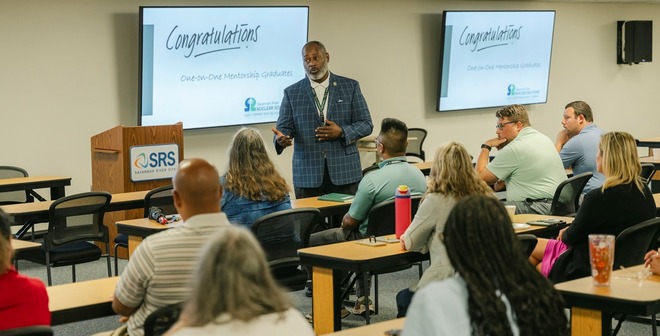 Savannah River Nuclear Solutions Executive Vice President and Chief Administrative Officer Sean Alford congratulates the third graduating cohort on completing the SRNS 1:1 Mentorship Program.
AIKEN, S.C. – On Aug. 23, nearly 75 employees graduated from an EM contractor’s third and largest 1:1 Mentorship Program cohort. Established last year, the six-month program promotes on-site safety and facilitates employee professional development in crucial areas of the Savannah River Site (SRS).
“SRS has a strong track record and history of performance that has prepared us to evolve rapidly in order to meet the needs of the nuclear industry,” said Sean Alford, Savannah River Nuclear Solutions (SRNS) executive vice president and chief administrative officer. “We commend those that choose to enroll in this program and further their capacity professionally or share their expertise through mentorship. I hope this cohort continues to pursue new opportunities that will leave a fingerprint on this organization.”
The 1:1 Mentorship Program is a continued effort by SRS in succession-planning, adding diverse leaders to the workforce and preserving critical missions. Over 180 employees have successfully completed the program while exploring new areas of the site and connecting with mentors outside of their own organizational sphere.
“Fifty-three percent of SRNS employees possess less than five years of on-site experience, which makes the availability of mentorship opportunities extremely important,” said Anitra McManus, SRNS program developer and manager. “This initiative fosters relationships between unlikely mentor-mentee pairs spanning various functional organizations.”
Site Service Human Capital Manager and Mentor Mike Violette believes the 1:1 Mentorship Program helps sustain the successful workplace and safety culture established by SRS contractors throughout history.
“We have a short period of time to onboard a large number of people to keep SRNS missions moving forward,” said Violette. “I’d like to challenge mid-to-senior level managers to take the leap and adopt a mentee. The future of our workforce depends on our ability to further these solutions, create new opportunities for employees to network across the site and build stronger workplace relationships.”
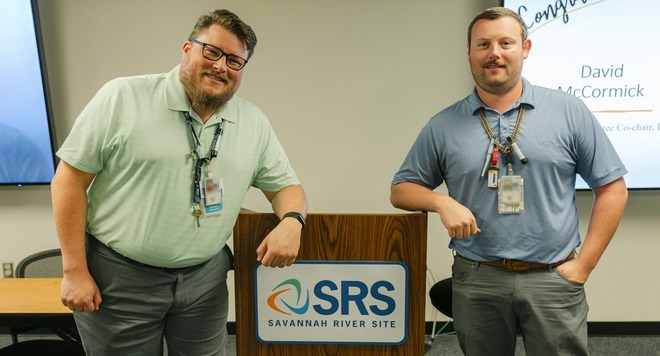 Mentor Mike Violette, left, and Mentee Zachary Burckhalter, right, were one of many pairs that graduated from the third 1:1 Mentorship Program cohort.
“Mike, my mentor, let me run the show and gave me some of the best advice I’ve ever received from the managerial level,” said Zachary Burckhalter, assistant first line manager, SRNS Maintenance and Outage Support. “This experience shows the importance of accepting new challenges, improving my professional skills and increasing my communication with other employees across the site.”
The 1:1 Mentorship Program contains a combination of activities that include: monthly meetings between mentor and mentee, the creation of a developmental action plan, knowledge-sharing sessions facilitated by senior and executive leaders, midpoint review sessions and a variety of safety topics. The fourth cohort is planned to begin in February 2024.
-Contributor: Mackenzie McNabb

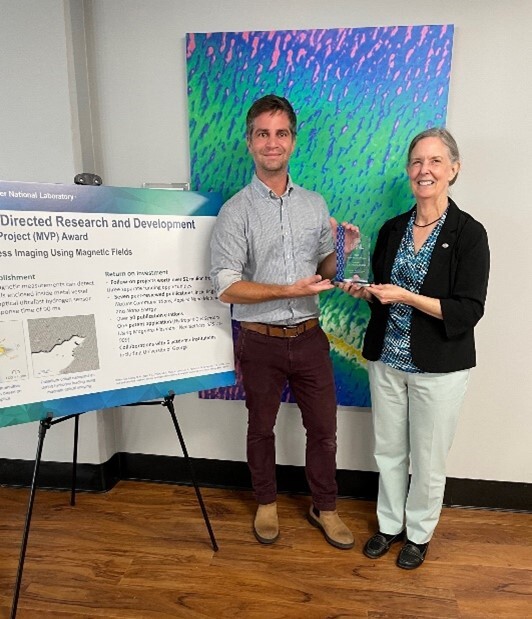 |
|
SRNL Deputy Director Sue Clark presents George Larsen with the LDRD MVP Award. |
AIKEN, S.C. – George Larsen and his project “Hydrogen Process Imagine Using Magnetic Fields” received this year’s Savannah River National Laboratory (SRNL) Laboratory Directed Research and Development (LDRD) Most Valuable Project (MVP) Award.
The LDRD MVP is awarded annually and recognizes the SRNL LDRD project that generated the highest return on investment during the previous five-year period. Project selection is based on 12 objective measures related to follow-on-funding, publications, presentations, intellectual property, new hires, partnerships and awards.
Larsen and his team presented new concepts for magnetic measurements of metal hydrides and successfully demonstrated these measurements can detect hydrogen in metals enclosed inside a metal vessel. The novel idea and sound execution of supporting research further resulted in developing advanced, ultrafast hydrogen sensors with record response times. The detection and monitoring of hydrogen isotopes in vessels or in the field can be used to support EM’s legacy waste mission and contributes to SRNL’s vitality in tritium and clean energy science.
Funded in fiscal years 2019 and 2020 by the LDRD program, this project and its legacy of innovation and novel scientific discovery continues to accumulate a remarkable return on investment, including:
Larsen cites close and complementary collaboration with University of Georgia Professor Tho Nguyen, and his students, Hoang Luong and Minh Pham, as a reason for the project’s success.
SRNL’s LDRD program emphasizes early exploration and application of creative and potentially transformational ideas that will enhance SRNL’s ability to execute current and future mission priorities.
-Contributor: Scott Shaw
|


















